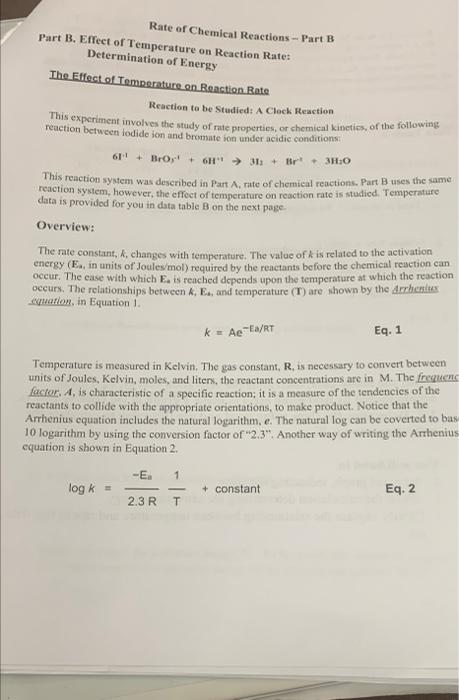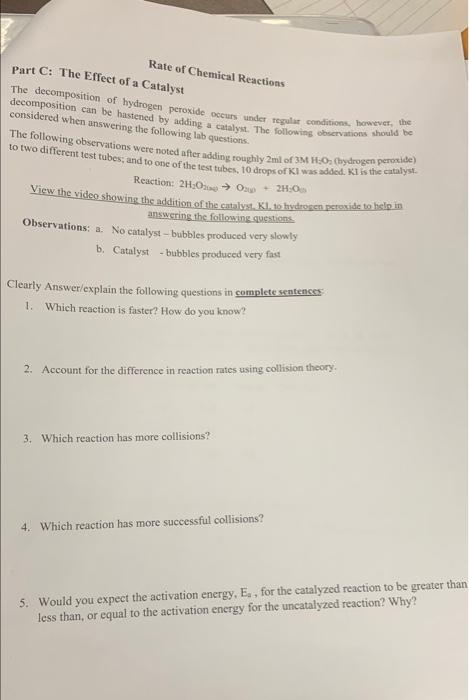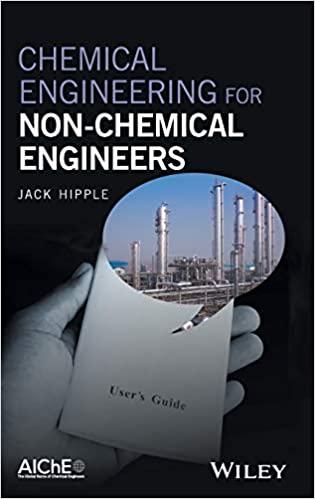Rate of Chemical Reactions - Part B Part B. Effect of Temperature on Reaction Rate: Determination of Energy The Effect of Temperature on Reaction Bate Reaction to be studied: A Clock Reaction This experiment involves the study of rate properties, or chemical kinetics, of the following reaction between iodide ion and bromate ion under acidic conditions 6 + Bro.6" 3 + Br. 31:0 This reaction system was described in Part A. rate of chemical reactions. Part B uses the same reaction system, however, the effect of temperature on reaction rate is studied. Temperature data is provided for you in data table B on the next page. Overview: The mate constant, &, changes with temperature. The value of k is related to the activation energy (E., in units of Joules mol) required by the reactants before the chemical reaction can occur. The case with which E. is reached depends upon the temperature at which the reaction occurs. The relationships between k, E, and temperature (T) are shown by the arrhostex mation in Equation 1 Eq. 1 k = Ae-ES/RT Temperature is measured in Kelvin, The gas constant, R, is necessary to convert between units of Joules, Kelvin, moles, and liters, the reactant concentrations are in M. The freuen factor. A. is characteristic of a specific reaction; it is a measure of the tendencies of the reactants to collide with the appropriate orientations, to make product. Notice that the Arrhenius equation includes the natural logarithm. e. The natural log can be coverted to bas 10 logarithm by using the conversion factor of "2,3". Another way of writing the Arthenius equation is shown in Equation 2. -E. 1 logk - + constant Eq. 2 2.3 R T Equation 2 is in the form of an "equation of a line" (=mx+) The x variable isi / they variable is "log *, and the slope of the line, mis --E/2.3R". R is the gas constena 8.31 Smole. When a plot is drawn of IT vs. log k the slope can be calculated and the activation energy, E. can be determined. Also, a particular k can be calculated for each reaction trial that is completed at a different temperature. The reaction rate at that temperature can then be determined Data Table B Approximate Temperature in C 21.9 C 470 oc 1 Time in seconds, for color to appear 188 54 480 2. Relative Rate = 1000/ 3. Log of relative rate 4. Temperature in K 51/T Using the above data, determine the activation energy, E. This is accomplished by first using excel to make a graph of log relative rate vs 1/T. Determine the slope using excel and use this value to calculate the activation energy, E. You will hand in: 1. the excel graph, indicating the slope 2. Show the calculation determining the activation energy 3. Clearly explain the relationship between temperature and rate in this data set Rate of Chemical Reactions Part C: The Effect of a Catalyst decomposition can be hastened by adding a catalyst. The following observations should be The decomposition of hydrogen peroxide occurs under regular conditions, however, the considered when answering the following lab questions. The following observations were noted after adding roughly 2ml of 3M H.O, hydrogen peroxide) to two different test tubes, and to one of the test tubes, 10 drops of Ke was added. Kl is the catalyst Reaction: 2H,021 O -- 2H: 09 View the video showing the addition of the catalyst. Kl. to hydrogen peroxide to help in answering the following questions Observations: a. No catalyst - bubbles produced very slowly b. Catalyst - bubbles produced very fast Clearly Answer/explain the following questions in complete sentences 1. Which reaction is faster? How do you know? 2. Account for the difference in reaction rates using collision theory 3. Which reaction has more collisions? 4. Which reaction has more successful collisions? 5. Would you expect the activation energy, E., for the catalyzed reaction to be greater than less than or equal to the activation energy for the uncatalyzed reaction? Why









